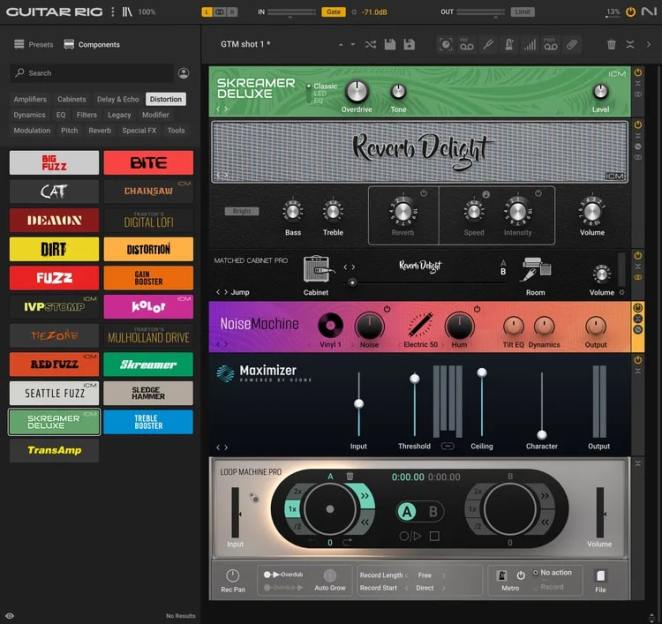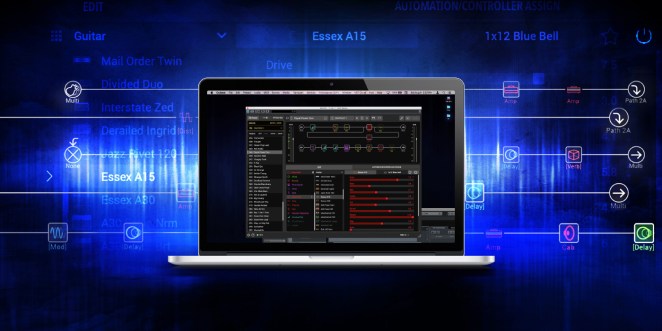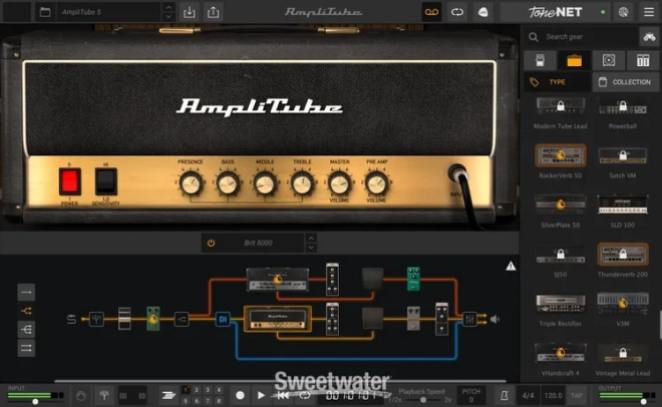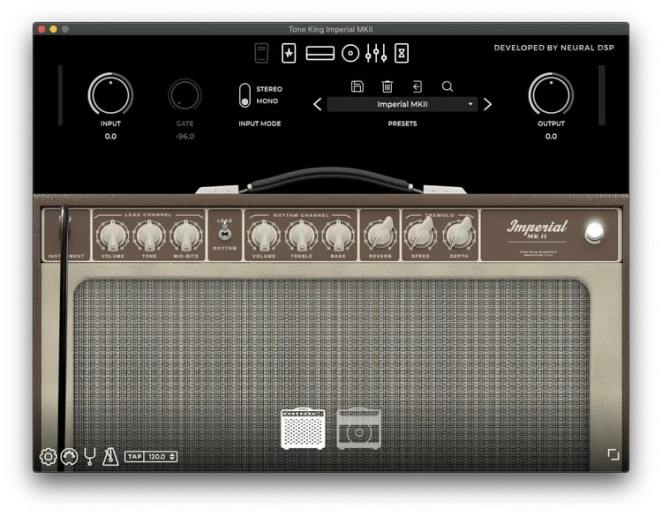When you buy through our links, we may earn an affiliate commission.
As I'm writing, I'm on tour in Japan. This is the first time I'm touring outside of Europe, so when it came to deciding what to bring with me, I aimed at bringing as little gear as possible without compromising my sound.
I ended up bringing my travel guitar, a looper pedal, a MIDI keyboard, an audio interface, a battery-powered amp, and the secret weapon – an amp simulator integrated into my DAW.

This minimal setup not only saved me plenty of headaches and luggage space but also gave me the opportunity to experiment with the power of amp simulations, something I had never done before. So here are my recommendations if you're looking for the best amp simulators out there, taking into account versatility, fidelity, and, of course, budget.
If you're curious about which amp simulator I brought with me at the end, the answer is the PreSonus Ampire: a phenomenal amp sim that gives me all the versatility I need when sculpting sounds, perfectly integrated into my DAW, and is reasonably priced.
However, all the other amp sims on this list are just as good, so keep reading and find out how to upgrade your guitar sound.
Quick Summary of the Best Amp Simulators
- Native Instruments Guitar Rig 7 (Best Amp Sim Under $100)
- Line 6 Helix Native (Best High-End Amp Sim)
- Positive Grid Bias FX 2 Elite (Best Amp Sim - Runner-up)
- IK Multimedia AmpliTube 5 (Best Simulation of Real Amps)
- Neural DSP Tone King Imperial MKII
- PreSonus Ampire (Best Amp Sim Overall)
- Waves PRS SuperModels (Best Affordable Amp Sim)
Best Amp Simulators
1. Best Amp Sim Under $100 – Native Instruments Guitar Rig 7

The latest Native Instruments Guitar Rig 7 Pro is a perfect blend of classic tones and innovative technology. The software comes with new rack-mounted effects and over 100 presets, opening up a plethora of creative possibilities.
The new version is driven by Intelligent Circuit Modelling (ICM), which brings to life four new amplifiers inspired by timeless analog models. Effects such as the Noise Machine, Vintage Vibrato, the Super Fast 100, and Reverb Delight provide a diverse range of tones from classic British crunch to American sounds, while the Loop Machine Pro is a great tool for both practice and performance settings.
For bass players, the Bass Rage gives you a realistic, tube-driven presence and truly shows the software's versatility.
A fantastic feature of the Guitar Rig 7 Pro is the integration of the Cabinet Impulse Response Loader, which allows users to emulate many iconic cabinets with exceptional realism. Coupled with a range of high-quality impulse responses, the Native Instruments Guitar Rig 7 offers an immersive and authentic tone replication for beginners and pros alike.
2. Best High-End Amp Sim – Line 6 Helix Native

With over 60 electric guitar and bass amplifier models, more than 100 effects, and support for third-party impulse responses, the Line 6 Helix Native is a powerhouse of sonic versatility for guitarists.
It's powered by an HX modeling engine that reproduces the sound of great amplifiers, cabinets, and effects, capturing everything from the classic compression of vintage amps to the dynamic punch of modern ones.
What I like about Helix Native is its intuitive, player-friendly workflow: extremely easy to use and modeled after the hardware units.
Helix Native is not just for guitars and basses: musicians can apply its effects to synthesize tracks, drums, or even vocals! The plug-in's versatility is further enhanced by the Helix 3.50 software update, which includes a revamped IR-based speaker cabinet engine, new amp models, effects, and more.
All in all, the Helix Native offers a combination of detailed modeling and a user-friendly interface that improves the workflow and gives plenty of sonic possibilities.
3. Best Amp Sim - Runner-up – Positive Grid Bias FX 2 Elite

The Positive Grid BIAS FX 2 Elite is an all-in-one solution for guitarists who need a wide spectrum of tones and effects. Combining cutting-edge technology, user-friendly design, and endless creative potential, this amp sim is an exceptional choice for both studio recordings and live performances.
It comes with an impressive collection of 100 amplifiers, 100 effects, and 18 rack processors, with the enhanced DSP engine that ensures each model is recreated with a nuanced and realistic sound.
The innovative Guitar Match function allows musicians to alter the fundamental sound of their guitar in post-production, allowing you to switch from a humbucker guitar tone to a single-coil sound during mixing, endlessly customizing your sound to fit the overall song vibe.
BIAS FX 2 Elite also has a user-friendly interface with dual rec signal path design and multiple splitters, simplifying the creation of intricate signal chains.
BIAS FX 2 Elite functions smoothly both as a plug-in for various DAWs and as standalone guitar amp software. It comes with a practical built-in looper/recorder to help you during practicing and songwriting sessions. Finally, it supports advanced MIDI control and automation, allowing detailed manipulation of nearly every parameter.
4. Best Simulation of Real Amps – IK Multimedia AmpliTube 5

The AmpliTube 5 MAX is a complete virtual studio environment that offers a realistic amp-like experience, a flexible signal chain, and an extensive model and effect library.
AmpliTube 5 MAX's Volumetric Impulse Response (VIR) cabinet engine is a fantastic feature that offers musicians access to over 143,000 impulse responses. This gives you plenty of control over the sound palette, with 600 IRs per speaker offering a detailed and three-dimensional approach to mic placement.
The software comes with a library of over 400 effects and models, including Fender, Orange, Fulltone, Leslie, and Mesa/Boogie, and personalized artist collections from iconic guitarists such as Slash, Jimi Hendrix, Dimebag Darrell, Brian May, and Joe Satriani.
Its signal chain can contain up to 57 models simultaneously, including amps, cabs, racks, and stomps. The Mixer section has been redesigned and simplified, making it easier to blend sounds from different mics, cabinets, and DI signals into a unified tone. You'll also find 19 mixing effects from the T-RackS, giving you all the professional post-production tools you'll need.
If that's not enough, for players who prefer standalone operation, AmpliTube 5 MAX also includes an onboard 8-track DAW/recorder with advanced waveform editing capabilities. As far as I'm concerned, guitar sims never sounded as realistic as the AmpliTube 5!
5. Neural DSP Tone King Imperial MKII

The Neural DSP Tone King Imperial MKII Suite offers authentic classic amp tones with an intuitive interface and customization options that make it a great addition for guitarists looking for realistic, boutique-style amp tones.
The two-channel design mirrors the original Tone King Imperial MKII: the Rhythm channel produces warm tones that break into a crunch when driven, while the Lead channel offers a throaty sound that can be fine-tuned with the Mid-Bite control. The Tone King Imperial MKII also features an emulated Ironman II Reactive Attenuator, which allows you to experiment with power amp saturation at consistent volume levels.
The Tone King Imperial MKII Suite's tone-shaping capabilities include three stompbox-style pre-effects: a Compressor, Overdrive-1, and Overdrive-2, all extremely versatile, and a 9-band EQ that provides detailed control over the frequency response.
The suite's post-effects include a BBD-style chorus, a rich Delay and Reverb palette, and a multifaceted wah effect, which can be used via a MIDI expression pedal or in auto-wah mode.
The realism of the Neural DSP is further enhanced by its detailed cabinet simulation module, which includes a wide selection of impulse responses (IRs), giving guitar players the possibility to choose from various virtual microphones and place them around the speakers, like what one would do in a real recording studio.
This setup provides a very authentic and customizable sound recording experience. Additionally, the suite's ability to use third-party IRs makes it even more versatile and suitable for all sorts of musical styles and needs.
6. Best Amp Sim Overall – PreSonus Ampire

PreSonus Ampire is an impressively versatile and authentic amp and pedal simulation plug-in. It comes with cutting-edge State Space Modeling technology, a plethora of amp models, speaker cabinets, and stompboxes, making it a great resource for both home studios and professional recording situations.
Let's talk about the advanced State Space Modeling feature, which is the highlight of this amp sim. This technology delves deep into the hardware's components, such as resistors, capacitors, tubes, and transformers, to create the most realistic simulation possible. If you're looking for an amp simulator that sounds like the real thing, you can't go wrong with Ampire.
This simulator offers five amp models. The MCM800, popular for its powerful 80s rock and metal tones; the timeless VC30, offering a bright, British-style sound; the Blackface Twin for classic American tube sounds with clean and driven tones; the Dual Amplifier with its rich overdrive and sustain; and the AMP STV, a bass amp with deep, tube-driven tones.
You can further customize your sound with 16 classic speaker cabinet impulse responses and adjustable microphone settings. The pedalboard within Ampire further adds to its versatility, featuring a range of stompboxes and eight classic effects such as Delay, EQ, Modulation, and Reverb.
7. Best Affordable Amp Sim – Waves PRS SuperModels

The result of a collaboration between Waves and Paul Reed Smith, the Waves PRS SuperModels is a versatile amp simulation plug-in that recreates the essence of three PRS amplifiers into the digital world: the PRS Archon, the legendary Dallas, and the ultra-rare Blue Sierra/V9.
The PRS Archon is a real chameleon of an amp. It can smoothly go from soft and clear tones to roaring distortion, making it perfect for just about any music style you can think of. Then there's the Dallas model, which mimics a classic American reverb amp, giving you those bright, sparkling cleans and a rich, full overdrive sound topped off with some sweet reverb. Finally, the Blue Sierra/V9 is a bit of a hidden gem: it was a prototype that led to the J-MOD 100 but never got its own release. It's great for getting crystal-clear sounds or a nice, gentle overdrive.
One of the coolest things about the PRS SuperModels is the way it handles cabinet sounds with its impulse response (IR) feature. It comes packed with eight unique cabinet sounds, all recorded by Paul Smith with some really high-quality mics and preamps. Plus, you can add in your own IRs from other sources, and with the nifty Phase Fix and Time Fix controls, you won't have to worry about any weird sound delays or mismatches. The Smart Mix control is a neat touch too, keeping your volumes nice and balanced when you're blending two cabinets together.
Waves PRS SuperModels adds some extra goodies that you won't find in the actual amps: there's a tone boost to give your sound some extra oomph, a digital tuner that works for all kinds of guitars, and a smart noise gate that keeps unwanted sounds out of your playing. You also get artist presets from big names like Devin Townsend and producer Chris Rakestraw, further expanding the range of sounds you can play with.
While you can find some excellent free amp sim, including the great Blue Cat Audio Free Guitar Amp Sim, the Waves PRS SuperModels is inexpensive and offers great value for money.
Best Amp Simulators Buyer's Guide
Now that you know which are the best amp sims out there, it's time to identify how you can find the one that suits your needs.
Sound Signature
The sound signature of your amp simulator is super important because it's what shapes your music and gives it character. If you're looking for a simulator that nails the sound of classic amps, it should bring that special warmth or edgy crunch that can really make your music stand out.
But it's also about how the simulator responds to your playing. You want the amp sim to react just like a real amp would when you change your playing style, whether you're going fingerstyle or hard strumming or switching up the volume. This responsiveness is a big deal, especially if you're the kind of musician who puts a lot of expression into your playing.
Integration with Existing Gear
Making sure your new amp simulator plays nice with the gear you already have is paramount. You don't want any hiccups in your creative flow, whether you're jamming at home or laying down tracks in the studio, especially if you're on stage.
For studio guitarists, the ability to get your simulator and your DAW or other recording software to talk to each other seamlessly is a top priority. Make sure you do some research before purchasing an amp sim, reading reviews and forums of other artists sharing their experiences with the amp sim and your DAW of choice.
While it might take some time to adjust to a new setup, the goal is always to make everything work together in perfect harmony so you can focus on what you do best – making great music.
Effects Included
Having a bunch of unique effects built into your amp simulator can really change the game. Plus, top-notch effects right inside the simulator mean you might not need extra pedals, which simplifies your setup and saves you some cash.
This is especially great if you're always on the move or if you're playing in a tight space. Plus, with a variety of effects ready to go, you can play around and get creative in ways you might not have thought of before. You can create your digital pedalboard to carry around with you at all times and be ready to perform at a moment's notice.
Bear in mind that it's not just about quantity. The best effects should go hand in hand with your amp models, making your sound even better without messing up the quality of your tone.
Budget
Budget is always a big deal when you're buying music gear.
When it comes to amp simulators, you've got to weigh up the cost against what you're getting in terms of features and quality. The pricier simulators like the Line 6 Helix Native might have an endless library and top-notch sound quality, but there are also some really good options out there that won't make your wallet cry. It's all about finding that sweet spot between what you need at a price you can handle.
Also, bear in mind that an amp simulator will cost you a fraction of what an actual pedalboard would cost you. Physical guitar pedals, especially the professional ones, don't come cheap, so an amp sim might well be a smart investment until you know the kind of physical pedals you need to sculpt your sound.
Frequently Asked Questions (FAQs)
What is the difference between a digital amp simulator and a traditional tube amplifier?
Digital amp sims use cutting-edge software to mimic the sound of old-school tube amplifiers. They're usually more flexible, easier to carry around as they're fully digital, and won't hurt your wallet as much. On the other hand, traditional tube amplifiers use actual vacuum tubes to make their sound, and a lot of musicians love them for their warm, rich tones, especially when you crank them up or push them hard.
Can amp simulators replicate the sound of specific classic or vintage amplifiers accurately?
Today's amp sim plugins can faithfully replicate the sound of classic and vintage amps, using modern technology to capture all the details that make those timeless amps so special, down to the resistors and capacitors. Analog purists tend to say nothing beats the real analog sound, but many of these software amp sims, like the Amp Room or the Positive Grid Bias FX 2 Elite, get so close that they're a great option for most guitarists.
How important is the latency in an amp simulator for live performances?
Latency is a crucial factor to consider when you're playing live. It's all about how quickly the sound comes out after you play a note. You want it to be as close to simultaneous as possible so that it feels natural and doesn't mess up your timing. Most high-quality amp plugins are designed to keep this delay really low, making them ideal for live shows.
Are amp simulators compatible with all types of guitars, including acoustic and bass guitars?
Most amp simulators are great with different types of electric guitars, but when it comes to acoustic and bass guitars, it depends on the simulator. Some models, like the Native Instruments Guitar Rig 7, have special settings or models just for acoustics or basses. It's always a good idea to check if the simulator fits your needs before you get it.
Can I integrate an amp simulator with my existing pedalboard or effects processors?
You can usually hook up your existing pedalboard and effects processors with an amp simulator. They often have options for connecting external pedals, which means you can combine them to create even more unique sounds and have more control over your guitar tone.
How do the built-in effects in amp simulators compare to standalone pedals?
Standalone pedals might give you more detailed control over specific effects and a tangible feel you won't get with built-in effects. However, many musicians find that the convenience and space-saving perks of having solid built-in effects make up for that.
Is it possible to use an amp simulator for both live performances and studio recordings?
Amp simulators are extremely flexible and great for both live performances and studio recording. They give you a range of sounds for live gigs and let you experiment with different tones in the studio without needing a bunch of different amps. Plus, the sound stays consistent whether you're on stage or in the studio, which is a huge plus.
Final Thoughts
That's all I've learned about amp sims, so I hope this guide will help you find the one that best suits your needs and budget.
While it all comes down to personal taste, I've been extremely happy with the PreSonus Ampire, especially for the sound realism and customization options. Alternatively, I'd go for the Positive Grid Bias FX 2 Elite: it offers an impressive selection of amps and effects, endless customization options, and a price that makes it valuable for beginners as much as seasoned players.
Have fun, and stay creative!
